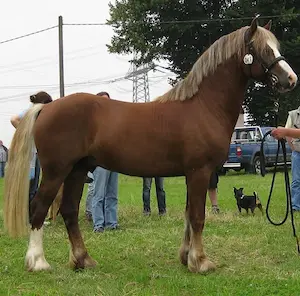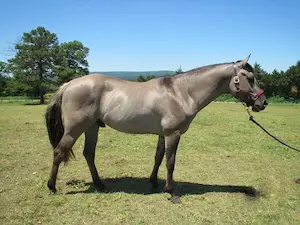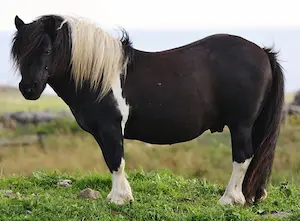If your child has been bitten by the riding bug then you’re bound to have heard the ‘can I have a pony’ question a few times. If you’re lucky enough to be able to get a pony for your child you’ll want to know what sort of pony is a good choice to start with.
When you begin looking for that special first pony you’re bound to have a head full of questions. Things like ‘should I go for a breed or grade pony’, ‘what’s a good age for a pony’ etc. It’s questions like this that I want to try and help you answer.
What is a good breed for a child?
If you’ve decided that you don’t want to buy a grade pony then you need to think about which breed is the best. There are literally hundreds of different breeds to choose from and there is a certain amount of personal preference but if you don’t have a favorite breed or preference these are some of the most popular children’s pony breeds:
Welsh Pony and Cob
The Welsh Pony and Cob is an extremely good all-round hardy breed that is perfectly suited to pretty much everything from English riding to Western riding, they have a gentle nature and plenty of stamina. The breed itself is formed of four sections that have their own characteristics but are all great first ponies.
Welsh Mountain Pony (Section A)
Standing at no higher than 12.2hh (or 12hh in the UK) it’s the smallest of all Welsh Sections and is ideally suited to smaller or younger children. They’re very elegant and have inherited a dished face from their Arabian ancestry.
Welsh Pony (Section B)
Slightly larger than the Welsh Mountain Pony (standing at 14.3hh in the US and 13.2hh in the UK) they’re great riding ponies with a willingness to please. Having more Thoroughbred than the Welsh Mountain Pony they tend to have a lighter build and make great jumpers.
Welsh Pony of Cob Type (Section C)
As its name suggests it much more cob like than the first two sections. They’re the most popular of all Welsh Sections and are loved for their strength as well as their temperament. The Welsh Pony of Cob Type makes an excellent jumper but is also happy as a driving pony.
Welsh Cob (Section D)
Bigger than the others the Welsh Cob must be at least 13.2hh and is ideal for both children and adults, so is perfect if you want a pony you can ride too! Like other Welsh Pony’s and Cob’s, it’s extremely hardy and good-natured and is just as happy as in hunter classes as it is in driving classes or in hand.
Quarter Pony
Like it’s bigger cousin, the Quarter Horse, the Quarter Pony really is a pony for all reasons, it’s just as happy as a show pony as it is in high speed barrel racing. It’s got a big heart and plenty of scope. While many have only Quarter Horse blood the registry does allow them to be crossed with other breeds so a Quarter Pony with Pony of The Americas blood isn’t uncommon at all.
Pony Of The Americas
Sometimes referred to as a smaller Appaloosa because of its spots the Pony of The Americas’ has combined the best characteristics of the Arab, Appaloosa and Shetland pony to make a hardy pony that has an enormous amount of stamina and is pretty much capable of anything. Standing between 11.2hh and 14hh you might be surprised to know that, because of its bone structure, the Pony of The Americas is actually a horse rather than a pony. Mainly used for Western riding its equally as capable in English disciplines.
Shetland Pony
A very popular choice for many first ponies because of its small size (approx. 9hh) as well as it’s extreme toughness, especially given its size. The Shetland pony and American Shetland pony are more or less the same breed with the only real difference being their height limit, 10.2hh for the Shetland and 11.2hh for the American Shetland. They’re also very fast and in the UK are raced in the ‘Shetland Pony Grand National’, a year-round event that raises money for charities.
Connemara Pony
Native to the Connemara region of Ireland from where it gets its name the Connemara Pony is an extremely popular breed, both in its own right but also for crossing with other breeds to increase their hardiness. Like the Welsh Cob it’s popular with children and adults and can turn its hoof to just about anything you ask it to do. They also have a great deal of stamina and are often used for endurance riding.
Dartmoor Pony
A prehistoric breed from the Dartmoor region of Great Britain, the Dartmoor is one of the hardiest breeds around. They can live outside in most conditions due to their thick waterproof coats. Classed as a mountain and moorland breed because of their native habitat they often have their own classes at shows as well as more breed special classes too.
If, however, you’re not worried about buying a particular breed then you might want to consider buying a grade pony instead.
What’s a grade pony?
Much like a mongrel dog, a grade pony is one from an unknown breed or mixture of breeds. Crossbred ponies are sometimes also referred to a grade ponies but, if the pony is a cross of known breeds then they can’t be classed a grade pony. A very good choice if you’re not worried about having a particular breed and are after a good all-round pony that is capable of doing anything.
What’s a good age for a pony?
When you’re buying a first pony you don’t want one that is too old to be ridden or so young that it needs an experienced handler. While a lot of ponies in their twenties still make great mounts, something between ten and eighteen is ideal. That way your children will have plenty of time to bond and grow with the pony will not having to worry about training them at all.
When should I buy my child a pony?
This question can’t really be answered by saying a particular age, it comes down to experience rather than age. If you (or your children’s riding instructor) feel that they are ready for the responsibility of owning their own pony then they’re of the right age.
What to look for when buying a pony
Now that you’ve got an idea of the type or breed of pony you’re after it’s time to start looking for that special first pony. If you’ve never bought a pony before it can be a very daunting experience but don’t worry a lot of us have been there and there’s plenty of help out there if you need it. You might also find this guide to buying a horse that I wrote helpful. If you’ve never bought a pony before the single best piece of advice I can offer you is to take somebody with you who has, you wouldn’t buy a house or car without seeking advice so why do it with a living creature.
Conclusion
Don’t rush to find a pony, if you take your time and buy the right pony rather than rush to buy the first one you find your children will have many years of happiness. After all, you never forget your first pony! If your children want to show their pony then you might find this article on preferring for a show helpful.
I hope you found this article helpful. If you did I’d be grateful if you could share it please as it would really help me.
Recommended products
Over the years I have tried hundreds of different horsey products, from various blankets and halters to different treats. Some I’ve loved, others I’ve hated but I thought I’d share with you my top all-time favorite products, the ones I never leave the yard without. I’ve included links to the products (which are in no particular order) that I really think are great.
- Horse Knots by Reference Ready – If you’re like me and enjoy pocket reference guides then you’ll love this knot tying guide. These handy cards can easily fit in your pocket or attach to the saddle for quick reference. They’re waterproof, durable and are color coded to make them easy to follow.
- Mane ’n Tail Detangler – Even if you never show your horse you’ll need to detangle his tail from time to time (and possibly his mane too) which is always a challenging chore! I’ve found that if I run a little bit of detangler through my horse’s tails every few days it stops them from getting matted up and makes combing them easy, even if they’re coated in mud. I don’t know if I should admit to this or not but it also works wonders on my hair.
- TAKEKIT Pro clippers – Over the years I’ve tried a lot of different clippers and while some were obviously better than others I found these to be by far the best. They are heavier than a lot of other clippers but for me, that’s a good thing, it makes them feel more sturdy and hardwearing. On top of that they have a range of speeds so are just as good for clipping your horse’s back as they are his face. I also like the fact that they come in a handy carry case but that’s not for everybody. The company that makes them is super good and incredibly helpful too, a real bonus these days. The only thing I wasn’t keen on was the fact that it doesn’t come with any oil, but that’s not a major problem as it’s not difficult to buy lubricant.
- Shire’s ball feeder – There are so many boredom buster toys out there but I like to use these every day, regardless of whether or not my horses are bored. I find that it helps to encourage my horses to problem solve by rewarding them with treats (or pieces of fruit) but it also mimics their natural grazing behavior which helps to keep them calm and de-stressed.
- Horse safe mirror – This is a strange one that many people are surprised about but I like to put horse safe mirrors in the trailers as well as in the quarantine stalls. It helps to prevent the feeling of isolation by giving the impression of other horses being around. Being herd animals horses can get extremely stressed when they feel that they’re on their own but with these stick-on mirrors, they believe that at least one other horse is with them.
- Rectal thermometer – I know this isn’t glamourous at all but it’s vital for your horse’s well-being to be able to check their temperature and a rectal thermometer is the easiest way of doing this which is why I’ve added it to the list.
Shopping lists
I’ve also put together a few shopping lists of essential items that I’ve found helpful over the years. I’ve broken the lists down into different categories rather than put everything in one massive list 😉










